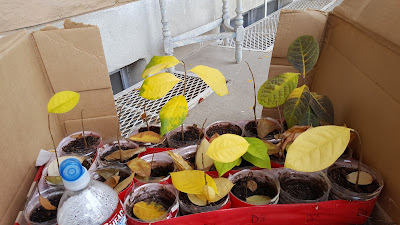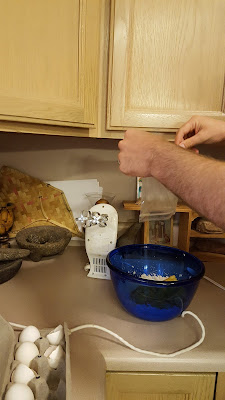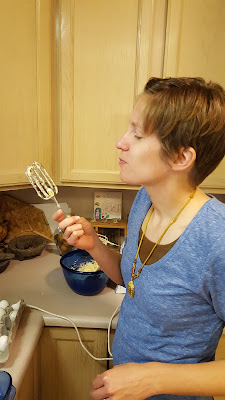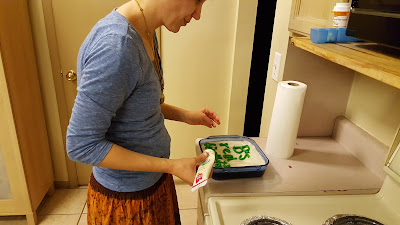A couple weeks ago I opened my inbox and found an email titled "Paw paws!"
As you can imagine, the subject line piqued my interest, and when I opened it, I learned that Dan Carpenter of Murray, Utah, has been working on growing pawpaws here in Utah. (By the way, I'm using his name with permission--I wouldn't just publish the name of someone who contacted me without their permission.) He had a few questions he wanted to bounce off me on the two cultivars he's planted (the NC-1 and the Mango).
In emailing with him, it also struck me that he might be up for being a guinea pig, as the first in a running series of blogposts titled "Utah Pawpaw Growers," which would feature email interviews with...(this may surprise you)...people in Utah who are growing pawpaws. As I explained by email: "Planting pawpaws in Utah--that's not normal like planting apple trees or peach trees; there's always a story about why someone decides to plant pawpaws in Utah. And I'm wondering if you'd be interested in being first in the series? I'm thinking in terms of a type of email interview, where I might send you a series of questions and you could write short answers to them. And then people featured in the series could send a few pics of their trees to be posted in the blog entry along with their answers." I also added: "If you were up for something like that, you could choose either to use your name or you could be anonymous or use initials or just a first name." He said it was fine to use his name, since he's had an online presence for years and hasn't worried about anonymity.
So here's Dan, responding to a few questions from me (all links added by me):
BR: How did you first hear of pawpaws?
DC: I first hear about Pawpaws a couple years back, on
The Survival Podcast. Jack Spirko is a big fan of looking "off the menu" for uncommon fruits and vegetables that can be grown, instead of only replicating the things that you see in your local supermarket. From his description, Pawpaws sounded fantastic, so I looked them up.
BR: Why pawpaws and not peaches?
DC: Why not both?!! I don't actually grow peaches (yet), but I do have a nectarine tree, an apricot tree, a dwarf pear tree, a grafted apple tree, a
Jujube tree, 2 Black Mulberry trees, 2 kinds of grapes,
Gojis, raspberries, blackberries, honeyberries, and a bunch of other herbs. I'm into FOOD. :-) Having said all that however, the Pawpaws do sound the most exotic and wonderful, so they do occupy a special place of hope in my heart.
BR: Which pawpaw cultivars did you choose and why?
DC: I have an
NC-1, and a
Mango. I chose them because they sounded so good!! :-) I was also fairly active in the
Utah Backyard Homesteading Facebook group, and there were a couple people in that group that had Pawpaws, and still hadn't killed them.
BR: Any challenges you've experienced growing pawpaws in Utah? How have you dealt with those challenges?
DC: Yes!!! I was very worried about my brand new little Pawpaw seedlings in the merciless summer of the Utah desert, so I planted my Pawpaw seedlings in large pots, and kept them inside my wood shop. I made a
Youtube video about this, and called them my "Pot Paws." Both my little seedlings are tiny little 12" tall twigs. I think my plants may be getting nutrient deficient. Halfway through the summer, the Mango Pawpaw's leaves began to get a little yellowy. At the time, I though it may be too little water, so I tried to water more. The leaves continued to get splotchier and curled up. It has looked like it's been dead for the last couple months, but I've continued to water it, hoping that the roots may still be alive, and come back next spring. over the last few weeks, the NC-1's leaves are beginning to look like that as well. I'm not sure what to do. [BR's note: I'm including Dan's pics below, with some discussion of what may be ailing them and some suggestions on an approach to planting pawpaws in Utah that I've had success with.]
BR: If you've already eaten a pawpaw, what would you compare the taste to?
DC: Sadly, I've never tasted Pawpaws. I tried mightily this last month however, when my family was in Florida and North Carolina. No amount of calling the colleges and growers, asking at wildlife preserves, or stopping at farmer's markets and fruit stands resulted in a single solitary Pawpaw. Sniff :-(.....................[BR's note: I just wanted to mention that although Dan and I are both Utah pawpaw growers, we only met because he went to North Carolina and talked on the phone with
Derek Morris of the North Carolina Pawpaw Festival, whose
NC Pawpaw Festival Facebook page has linked to my blog several times. When Dan and Derek were talking on the phone and Derek realized Dan was from Utah, he told him about a guy--me--out in Utah growing pawpaws. It's a little wild--and a lot fortuitous--that two Utah pawpaw growers would be introduced to each other by the North Carolina Pawpaw Festival's organizer.]
BR: Is there a question about pawpaws that you wish I had asked but didn't? What's the question and how would you answer it?
DC: There are a lot of questions that I still have, but I'm not sure my little trees will even make it, so I don't think I have any answers yet!
 |
| Dan took this pic earlier this year when he was planting his pawpaws |
 |
| This is the NC-1 that Dan refers to above. Pic taken this month, Oct 2016. Note the leaves looking wilty and unhealthy. The look similar to my Wells pawpaw earlier this year. To read about how I approached this problem, take a look here and here.............But I'm not sure it's the same problem. When Dan and I talked, he explained that he had been giving them a lot of water, which is similar to what I do for my pawpaws. But I speculated that it could be that with my pawpaws (which are in the ground), the excess water drains away. And with his pawpaws (which are in containers), the excess water may be drowning the roots? I told him that every time I've planted a pawpaw tree in Utah, I've planted it in the spring, having it delivered from One Green World in April or May and planting it in the ground immediately. I've only lost one pawpaw with this approach, and that was because the graft failed. So that's my recommended approach to planting pawpaws in Utah: spring planting in the ground, and plenty of water, counting on that excess water will sink into the ground and not waterlog the soil. Here's a post detailing how I planted two pawpaw trees in spring of this year. |
 |
| Another view of Dan's NC-1 |
 |
| Dan's Mango cultivar, which as he mentioned lost its leaves earlier this season after planting. I'm not sure why, but if I were to take a stab, I'd suggest either over-watering or graft failure. He's right that the roots are probably still alive, and .... |
 |
| This is also of Dan's Mango cultivar--looks like there's an upper branch that lost all its leaves and a lower branch (pictured here) that still has some shriveled leaves hanging on. |
Also, here's the Youtube video Dan referenced in his answers:
"Pot Paws." You'll see that in the video, he's concerned about his pawpaws getting too much sun. It's a legitimate concern, and he's got a good solution, I think. But my understanding (as I told him when we talked) is that this would be a
good approach to seedlings (pawpaw plants that have just germinated during the present season), while grafted cultivars are already old enough that we don't need to worry about them getting a sunburn. That's been my experience anyway.










































































